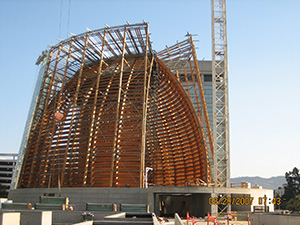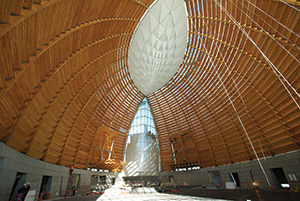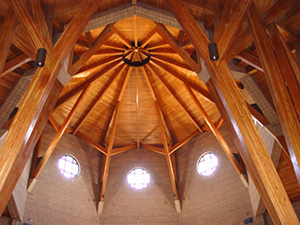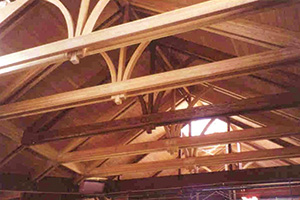Churches and other religious buildings demand large, open spaces that must be as inspiring as they are structurally sound. In many cases, glulam can be the answer to the architect’s prayers. These large public buildings, where aesthetics are key, can be designed with curved beams, trusses, traditional Tudor arches or complex beam, column and arch framing systems that feature the natural beauty of wood in an exposed glulam structure.

Glulam Creates Unique Place of Worship
The framing of Cathedral of Christ the Light, in Oakland, California is unlike any other structure. Two large glulam and steel space frames form the outer walls. The frame consists of two intersecting circles, creating a football-like shape. The inner chords are made with (26) 10-3/4-inch curved glulam ribs, roughly 100 feet in length, and varying in depth from 30 inches at the base to 19-1/2 inches at the top. The outer chords are made of straight glulam mullions, which are roughly 103 feet long.
Because the framing is so unique and doesn’t follow any of the structural types listed in the 2001 California Building Code, the City of Oakland Building Department required the engineer of record to establish a peer review committee to help develop the requirements of this framing system. This peer review committee consisted of three university professors and an industry expert. The committee developed the criteria for the structure’s ductility and toughness to resist seismic activity. The building is designed to withstand a 1000-year seismic event. In addition to its magnificent outer beauty, the sanctuary also features two organ lofts built with curved glulam members.

APA member Western Wood Structures, Inc. of Tualatin, Oregon was the supplier and erector of all the glulam and steel components. The glulam ribs and the frames for the organ loft were manufactured by APA EWS member Alamco Wood Products, Inc. of Albert Lea, Minnesota. All other glulam members were manufactured by APA EWS member American Laminators of Drain, Oregon.
Photos courtesy of The Cathedral of Christ the Light.
 Glulam Delivers Strength and Versatility
Glulam Delivers Strength and Versatility
The strength and versatility of glulam make it an ideal choice for large, open building designs where long spans are required, like St. Joseph Catholic Church in Amery, Wisconsin. Designers can employ glulam to create open, airy designs and high ceilings that are popular in today’s churches. Glulam is engineered to meet specific performance criteria to provide consistent performance for decades. At St. Joseph Catholic Church, glulam was used to create Tudor arches, parallel chord trusses, rafters, and other architectural framing members.

Glulam Demonstrates Cost-Effectiveness and Quality
Glulam building systems are cost-effective alternatives to steel and concrete, filling the need for beautifully renovated worship and community spaces at competitive costs. Glulam beams are easy to install for timely and affordable construction. Pound for pound, glulam is stronger than steel, so glulam beams can span long distances with minimal need for intermediate supports. These facts, combined with wood’s warm, welcoming atmosphere, makes glulam the perfect choice for renovations and additions. Glulam timber trusses were used to create this 16,000-square-foot addition to St. Matthew’s Lutheran Church in Stony Plain, Alberta.
 Bringing People Together Through Design
Bringing People Together Through Design
Our Lady of Loreto in Foxfield, Colorado, provides an example of how glulam can be used effectively in large churches. Using beams manufactured by APA member Calvert Company, Our Lady of Loreto’s design emphasizes three transepts connected by a central dome over the main sanctuary. Church design is shifting to broad, fan-shaped or other geometric shaped structures featuring long clear spans and large open spaces. In large churches like Our Lady of Loreto, glulam works well because it can span long distances with a minimal number of intermediate supports. Through this design, no one will be more than 70 feet from the altar of sacrifice when seated anywhere in the church.

A Natural Work of Art
This synagogue in New York City is a striking example of the breathtaking beauty achievable with architectural heavy timber beams. The roof structure was created by the G.R. Plume Company. The project was in planning for five years, but construction took just six months. Rather than glued laminated beams the job called for 54 Douglas-fir beams covered with a veneer of white oak and shaped into ribs that tapered from eight to two inches. The custom-manufactured ribs were crafted in Ferndale and shipped to New York for installation. “We planned for 10 weeks of installation, but only took three because the beams fit perfectly,” said Plume. “The owner wanted a unique worship space, and the result was inspiring.”

Glulam’s Versatility Allows Complex Design
St. Elizabeth Seton Catholic Church in Carlsbad, California, designed by Dominy + Associates @ domusstudio, LLP, is an example of a project that features single tapered jobsite-assembled glulam and steel trusses. According to Don Whitacre of D.A. Whitacre Construction, it was a more complex assembly than they typically see. “But it looks much better as a result,” he’s quick to add. The project featured 16 glulam trusses fabricated by APA member Standard Structures from 5-1/8" x 16- and 18-inch Douglas-fir components that were sandwiched together over hidden steel connectors. Whitacre says that the project was unique and complex, but says the end result was definitely worth the effort. “Parishioners are very pleased and impressed, because it is such an intricate combination of beams, struts and angles.” The project has also won numerous awards from design, architectural and engineering associations.
Photo courtesy Standard Structures.
 Glulam Provides a Strong Sense of History
Glulam Provides a Strong Sense of History
When the Algonquin, Illinois, congregation of St. John’s Lutheran Church found themselves outgrowing their historic building, they knew they wanted to replace it with a building that fit well within the community. “Laminated wood fit our building’s structural design concept, and it provided warmth, authentic aesthetic finish and a strong sense of history,” said architect Tom Jaeger, principal at Jaeger, Nickola & Associates Ltd. of Park Ridge, Illinois. Daniel O’Byrn is president of Engineered Wood Sales Inc. of nearby Oakbrook. He says he sourced the 22,126 board feet of architectural grade Douglas-fir beams for the project from ALAMCO Wood Products, an APA member. More than 50 glulam purlins are supported by two main carrying beams, 8-3/4" x 58-1/2" x 59 feet long. Glulam beams also support the tall spire of the church that towers over the little town. Claire Vermedahl, CEO of ALAMCO, said, “We can use glulam to create virtually any shape – we can even replicate old designs. Laminated beams give us a warmth and a comfort that comes from seeing something other than a sterile, flat roof.”
Photo courtesy of David Miezal
 Glulam an Easy Sell Over Other Building Components
Glulam an Easy Sell Over Other Building Components
One of the largest heavy timber roof structures in Northern Nevada can be found in Carson City, Nevada. Trusses and purlins for St. Teresa of Avila Catholic Church were manufactured by American Laminators, an APA member, and then prefabricated by Western Wood Structures to reduce jobsite labor. Roof installation for the 11,500-square-foot sanctuary took just two months as a result. Steve Turner, president of Western Wood Structures, says the project was originally specified in parallel strand lumber. “Glulam was an easy substitute,” he remembers. “Member sizes were comparable, so the design didn’t change. In addition, glulam is lighter so our design saved installation cost.” The architect, contractor and parish priest were all sold on the beauty of natural wood.